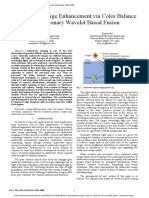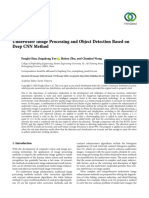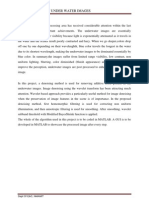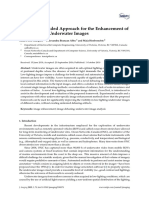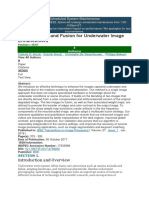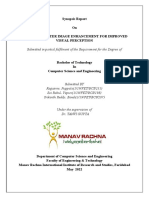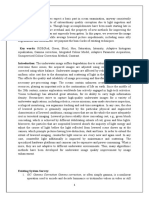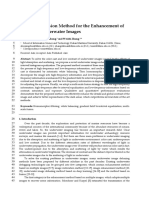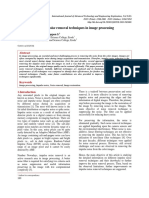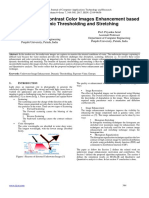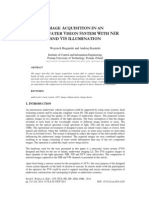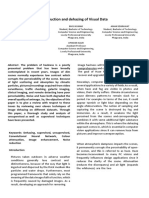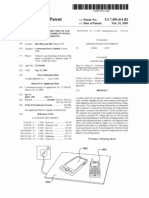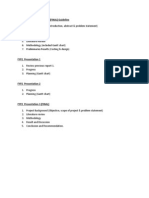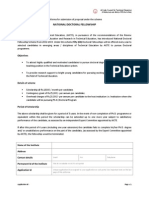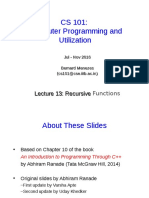An Image Based Technique For Enhancement of Underwater Images
An Image Based Technique For Enhancement of Underwater Images
Uploaded by
anaqiaisyahCopyright:
Available Formats
An Image Based Technique For Enhancement of Underwater Images
An Image Based Technique For Enhancement of Underwater Images
Uploaded by
anaqiaisyahOriginal Description:
Original Title
Copyright
Available Formats
Share this document
Did you find this document useful?
Is this content inappropriate?
Copyright:
Available Formats
An Image Based Technique For Enhancement of Underwater Images
An Image Based Technique For Enhancement of Underwater Images
Uploaded by
anaqiaisyahCopyright:
Available Formats
217
Bioinfo Publications
I J M I
International Journal of Machine Intelligence
ISSN: 09752927 & E-ISSN: 09759166, Volume 3, Issue 4, 2011, pp-217-224
Available online at http://www.bioinfo.in/contents.php?id=31
AN IMAGE BASED TECHNIQUE FOR ENHANCEMENT OF UNDERWATER IMAGES
PRABHAKAR C.J.
1*
, PRAVEEN KUMAR P.U.
1
1
Department of P.G. Studies and Research in Computer Science
Kuvempu University, Shankaraghatta-577451, Karnataka, India.
*Corresponding Author: Email- psajjan@yahoo.com
Received: November 06, 2011; Accepted: December 09, 2011
Abstract - The underwater images usually suffers from non-uniform lighting, low contrast, blur and diminished colors. In this
paper, we proposed an image based preprocessing technique to enhance the quality of the underwater images. The proposed
technique comprises a combination of four filters such as homomorphic filtering, wavelet denoising, bilateral filter and contrast
equalization. These filters are applied sequentially on degraded underwater images. The literature survey reveals that image
based preprocessing algorithms uses standard filter techniques with various combinations. For smoothing the image, the
image based preprocessing algorithms uses the anisotropic filter. The main drawback of the anisotropic filter is that iterative in
nature and computation time is high compared to bilateral filter. In the proposed technique, in addition to other three filters, we
employ a bilateral filter for smoothing the image. The experimentation is carried out in two stages. In the first stage, we have
conducted various experiments on captured images and estimated optimal parameters for bilateral filter. Similarly, optimal
filter bank and optimal wavelet shrinkage function are estimated for wavelet denoising. In the second stage, we conducted the
experiments using estimated optimal parameters, optimal filter bank and optimal wavelet shrinkage function for evaluating the
proposed technique. We evaluated the technique using quantitative based criteria such as a gradient magnitude histogram
and Peak Signal to Noise Ratio (PSNR). Further, the results are qualitatively evaluated based on edge detection results. The
proposed technique enhances the quality of the underwater images and can be employed prior to apply computer vision
techniques.
Key words - Underwater image preprocessing, Homomorphic Filter, Bilateral Filter, BayesShrink, Contrast Equalization
1. INTRODUCTION
Underwater vision is one of the scientific fields of
investigation for researchers. Autonomous Underwater
Vehicles (AUV) and Remotely Operated Vehicles (ROV)
are usually employed to capture the data such as
underwater mines, shipwrecks, coral reefs, pipelines and
telecommunication cables from the underwater
environment. Underwater images are essentially
characterized by their poor visibility because light is
exponentially attenuated as it travels in the water, and the
scenes result poorly contrasted and hazy. Light
attenuation limits the visibility distance at about twenty
meters in clear water and five meters or less in turbid
water. The light attenuation process is caused by
absorption and scattering, which influence the overall
performance of underwater imaging systems. Forward
scattering generally leads to blur of the image features.
On the other hand, backscattering generally limits the
contrast of the images, generating a characteristic veil
that superimposes itself on the image and hides the
scene. Absorption and scattering effects are not only due
to the water itself but also due to the components such as
a dissolved organic matter. The visibility range can be
increased with artificial illumination of light on the object,
but it produces non-uniform of light on the surface of the
object and producing a bright spot in the center of the
image with poorly illuminated area surrounding it. The
amount of light is reduced when we go deeper, colors
drop off depending on their wavelengths. The blue color
travels across the longest in the water due to its shortest
wavelength. Underwater image suffers from limited range
visibility, low contrast, non-uniform lighting, blurring, bright
artifacts, color diminished and noise.
The research on underwater image processing can be
addressed from two different points of view such as an
image restoration or an image enhancement method [1,
16-18]. The image restoration aims to recover a degraded
image using a model of the degradation and of the
original image formation; it is essentially an inverse
problem. These methods are rigorous, but they require
many model parameters like attenuation and diffusion
coefficients that characterize the water turbidity and can
be extremely variable. Whereas image enhancement
uses qualitative subjective criteria to produce a more
visually pleasing image and they do not rely on any
physical model for the image formation. These kinds of
approaches are usually simpler and faster than
deconvolution methods. Recently, many researchers have
developed preprocessing techniques for underwater
images using image enhancement methods. Bazeille et
al. [3] propose an algorithm to pre-process underwater
images. It reduces underwater perturbations and
Prabhakar CJ, Praveen Kumar PU
218
Bioinfo Publications
improves image quality. The algorithm is automatic and
requires no parameter adjustment. The method was used
as a preliminary step of edge detection. The robustness of
the method was analyzed using gradient magnitude
histograms and also the criterion used by Arnold-Bos et
al. [2] was applied. This criterion assumes that well-
contrasted and noise-free images have a distribution of
the gradient magnitude histogram close to exponential,
and it attributes a mark from zero to one.
Chambah et al. [4] proposed a color correction method
based on the Automatic Color Equalization (ACE) model,
an unsupervised color equalization algorithm developed
by Rizzi et al. [5]. ACE is a perceptual approach inspired
by some adaptation mechanisms of the human vision
system, in particular, lightness constancy and color
constancy. ACE was applied on videos taken in an
aquatic environment that present a strong and non-
uniform color cast due to the depth of the water and the
artificial illumination. Images were taken from the tanks of
an aquarium. Iqbal et al. [6] presented an underwater
image enhancement method using an integrated color
model. They proposed an approach based on a slide
stretching: first, contrast stretching of RGB algorithm is
used to equalize the color contrast in the images. Second,
saturation and intensity stretching of HSI is applied to
increase the true color and solve the problem of lighting.
The blue color component in the image is controlled by
the saturation and intensity to create the range from pale
blue to deep blue. The contrast ratio is therefore
controlled by decreasing or increasing its value.
Arnold-Bos et al. [2] presented a complete pre-
processing framework for underwater images. They
investigated the possibility of addressing the whole range
of noises present in underwater images by a combination
of deconvolution and enhancement methods. First, a
contrast equalization system is proposed to reject
backscattering, attenuation and lighting inequalities. If
( , ) I i j is the original image and ( , )
LP
I i j its low-pass
version, a contrast-equalized version of
I is .
eq LP
I I I = The additional use of adaptive
smoothing helps to address the remaining sources of
noise, which is corresponding to sensor noise, floating
particles and miscellaneous quantification errors. This
method applies local contrast equalization method as a
first step in order to deal with non-uniform lighting caused
by backscattering. Generally, contrast equalization will
raise the noise level in poorly contrasted areas of the
original image. Signal to noise ratio would remain
constant after equalization; but the fixed color
quantization step induces strong errors in dark zones.
Compared to the local contrast equalization method, the
homomorphic filtering (which adopts the illumination-
reflectance model) has a slightly more important effect on
noise in dark zones.
In this paper, we propose a preprocessing technique,
which consists of sequentially applying filters such as
homomorphic filtering, wavelet denoising, bilateral filtering
and contrast stretching. First, we apply homomorphic filter
to correct non-uniform illumination of light. Homomorphic
filter simultaneously normalizes the brightness across an
image and increases contrast. The homomorphic filtering
performs in the frequency domain and it adopts the
illumination and reflectance model. Wavelet based image
denoising techniques are necessary to remove random
additive Gaussian noise while retaining as much as
possible the important image features. The main objective
of these types of random noise removal is to suppress the
noise while preserving the original image details. We use
the bilateral filter to smooth the image while preserving
edges and enhance them. Finally, we apply contrast
stretching for normalizing the RGB values. The remaining
sections of the paper are organized as follows: section 2
describes proposed technique in detail. The experimental
results are presented in the section 3. Finally, the section
4 concludes the paper.
2. A PREPROCESSING ALGORITHM
In this section, we present filters, which are adopted in the
proposed technique. These filters are employed
sequentially on degraded images.
Homomorphic Filtering
Homomorphic filtering is used to correct non-uniform
illumination and to enhance contrasts in the image. Its a
frequency filtering, preferred to others techniques
because it corrects non-uniform lighting and sharpens the
image features at the same time. We consider that image
is a function of the product of the illumination and the
reflectance as shown below.
( , ) ( , ) ( , ), f x y i x y r x y = (1)
where ( , ) f x y is the image sensed by the camera,
( , ) i x y the illumination multiplicative factor, and
( , ) r x y the reflectance function. If we take into account
this model, we assume that the illumination factor
changes slowly through the view field; therefore it
represents low frequencies in the Fourier transform of the
image. On the contrary reflectance is associated with high
frequency components. By multiplying these components
by a high-pass filter we can then suppress the low
frequencies i.e., the non-uniform illumination in the image.
The algorithm can be decomposed as follows:
Separation of the illumination and reflectance
components by taking the logarithm of the image. The
logarithm converts the multiplicative into an additive one.
( , ) ln( ( , )) ln( ( , ) ( , )) g x y f x y i x y r x y = =
( , ) ln( ( , )) ln( ( , )). g x y i x y r x y = + (2)
Computation of the Fourier transform of the log-image
[
( , ) ( , ) ( , ).
x y x y x y
G w w I w w R w w = + (3)
High-pass filtering is applied to the Fourier transform
decreases the contribution of low frequencies
(illumination) and also amplifies the contribution of mid
and high frequencies (reflectance), sharpening the image
features of the objects in the image
An Image Based Technique for Enhancement of Underwater Images
219
International Journal of Machine Intelligence
ISSN: 09752927 & E-ISSN: 09759166, Volume 3, Issue 4, 2011
( , ) ( , ) ( , )
( , ) ( , ), (4)
x y x y x y
x y x y
S w w H w w I w w
H w w R w w
=
+
with,
2 2
2
( , ) ( ) (1 exp( ( ))) . (5)
2
x y
x y H L L
w
w w
H w w r r r
+
= +
where, 2.5
H
r = and 0.5
L
r = are the maximum and
minimum coefficients values and
w
a factor which
controls the cut-off frequency. These parameters are
selected empirically. Computations of the inverse Fourier
transform to come back in the spatial domain and then
taking the exponent to obtain the filtered image.
Wavelet Denoising
Thresholding is a simple non-linear technique, which
operates on one wavelet coefficient at a time. In its most
basic form, each coefficient is thresholded by comparing
against threshold, if the coefficient is smaller than
threshold, set to zero; otherwise it is kept or modified.
Replacing the small noisy coefficients by zero and inverse
wavelet transform on the result may lead to reconstruction
with the essential signal characteristics and with the less
noise. A simple denoising algorithm that uses the wavelet
transform consist of the following three steps, (1)
calculate the wavelet transform of the noisy signal (2)
Modify the noisy detail wavelet coefficients according to
some rule (3) compute the inverse transform using the
modified coefficients.
Let us consider a signal { , , 1,..., },
ij
f i j N = where
N is some integer power of 2. It has been corrupted by
additive noise and one observes
, , 1,...,
ij ij ij
g f i j N = + = (6)
where
ij
are independent and identically distributed (iid)
zero mean, white Gaussian noise with standard deviation
i.e.
2
(0, ) N and independent of
ij
f . From the noisy
signal
ij
g we want to find an approximation
ij
f . The goal
is to remove the noise, or denoise ( , ), g i j and to obtain
an estimate
ij
f and
ij
f which minimizes the mean
squared error (MSE),
2
2
, 1
1
( ) ( ) .
N
ij ij
i j
MSE f f f
N
=
=
(7)
Let
,
{ } ,
ij i j
g = g
,
{ } ,
ij i j
f = f and
,
{ }
ij i j
= ; that is,
the boldfaced letters will denote the matrix representation
of the signals under consideration.
Let , D w =
g
, C w =
f
and Z w =
denote the matrix of
wavelet coefficients g, f, respectively. Where, w is the
two-dimensional dyadic orthogonal wavelet transform
operator. It is convenient to label the subbands of the
wavelet transform. The subbands,
, ,
k k k
HH HL LH are called the details, where
1,..., k J = is the scale, with J being the largest (or
coarsest) scale in the decomposition and a subband at
scalek has size / 2 / 2
k k
N N . The subband
j
LL is
the low resolution residual and is typically chosen large
enough such that / 2 , / 2 1.
j j
N N N s > The wavelet
based denoising method filters each coefficient
ij
g from
the detail subbands with a threshold function to
obtain
.
ij
f The denoised estimate is then
1
, g w f
=
where
1
w
is the inverse wavelet transform.
Wavelet transform of noisy signal should be taken first
and then thresholding function is applied on it. Finally the
output should be undergone inverse wavelet
transformation to obtain the estimate
f . There are two
thresholding functions frequently used, i.e. a hard
threshold and soft threshold. The hard-thresholding
function keeps the input if it is larger than the threshold;
otherwise, it is set to zero. It is described as:
1
( ) (| | ), w wI w T = > (8)
where w is a wavelet coefficient, T is the threshold
and ( ) I x is a function the result is one when x is true and
zero vice versa. The soft-thresholding function (also
called the shrinkage function) takes the argument and
shrinks it toward zero by the threshold. It is described as:
2
( ) ( sgn( ) ) (| | ), w w w T I w T = > (9)
where sgn( ) x is the sign of x . The soft-thresholding rule
is chosen over hard-thresholding, the soft-thresholding
method yields more visually pleasant images over hard-
thresholding [7]. The BayesShrink function [8] has been
attracting recently as an algorithm for setting different
thresholds for every subband. Here subbands are
frequently bands that differ from each other in level and
direction. The BayesShrink function is effective for images
including Gaussian noise. The observation model is
expressed as follows: . Y X V = +
Here Y is the wavelet transform of the degraded
image, X is the wavelet transform of the original image,
and V denotes the wavelet transform of the noise
components following the Gaussian distribution
2
(0, ) N . Here, since X and V are mutually
independent, the variances
2 2
,
y x
and
2
v
of
, y x andv are given by:
2 2 2
.
y x v
= + (10)
Let us present a method for deriving of the noise: It
has been shown that the noise standard deviation
v
can
be accurately estimated from the first decomposition level
Prabhakar CJ, Praveen Kumar PU
220
Bioinfo Publications
diagonal subband
1
HH by the robust and accurate
median estimator.
2 1
(| |)
.
0.6745
v
median HH
= (11)
The variance of the degraded image can be estimated as
2 2
1
1
,
M
y m
m
A
M
=
=
(12)
where
m
A are the coefficients of wavelet in every scale
M is the total number of coefficient of wavelet. The
threshold value T can be calculated using
2
v
MBS
x
T
= (13)
where
log
,
2
M
j
=
M is the total of coefficients of
wavelet, j is the wavelet decomposition level present in
the subband coefficients under scrutiny and
2 2
max( ).
x y v
= Note that in the case where
2 2 2
,
v y x
> is taken to be zero, i.e. .
MBS
T
Alternatively, in practice one may choose
max| |,
MBS m
T A = and all coefficients are set to zero.
In summary, the Modified BayesShrink thresholding
technique performs soft thresholding with adaptive data
driven subband and level dependent near optimal
threshold given by:
2
2 2
max| |,
v
v y
MBS x
m
if
T
A otherwise
<
=
(14)
Bilateral Filtering
Bilateral filtering smooth the images while preserving
edges, by means of a nonlinear combination of nearby
image values [15]. The idea underlying bilateral filtering is
to do in the range of an image what traditional filters do in
its domain. Two pixels can be close to one another, that
is, occupy nearby spatial location, or they can be similar
to one another, that is, have nearby values, possibly in a
perceptually meaningful fashion. Closeness refers to
vicinity in the domain, similarity to vicinity in the range.
Traditional filtering is a domain filtering, and enforces
closeness by weighing pixel values with coefficients that
fall off with distance. The range filtering, this averages
image values with weights that decay with dissimilarity.
Range filters are nonlinear because their weights depend
on image intensity or color. Computationally, they are no
more complex than standard non-separable filters. The
combination of both domain and range filtering is termed
as bilateral filtering. A low-pass domain filter to an image
(x) f produces an output image defined as follows:
1
( ) ( ) ( ) ( , ) ,
d
x k x c x d
=
} }
h f (15)
where ( ,x) c measures the geometric closeness
between the neighborhood center xand a nearby point
. The bold font for f and h emphasizes the fact that
both input and output images may be multiband. If low-
pass filtering is to preserve the dc component of low-pass
signals we obtain
( ) ( , ) ,
d
k x c x d
=
} }
(16)
If the filter is shift-invariant, ( ,x) c is only a function
of the vector difference x , and
d
k is constant.
Range filtering is similarly defined:
1
( ) ( ) ( ) ( ( ), ( )) . h x x f f f x
r
k s d
=
} }
(17)
Except that now ( ( ), ( )) f f x s measures the
photometric similarity between the pixel at the
neighborhood center xand that of a nearby point .
Thus, the similarity function s operates in the range of the
image functionf , while the closeness function c operates
in the domain off . The normalization constant in Eq. (16)
is replaced by
( ) ( ( ), ( )) . f f
r
k x s x d
=
} }
(18)
Contrary to what occurs with the closeness functionc ,
the normalization for the similarity function s depends on
the imagef . The similarity functions is unbiased if it
depends only on the difference ( ) ( ). f f x The
combined domain and range filtering will be denoted as
bilateral filtering, which enforces both geometric and
photometric locality. Combined filtering can be described
as follows:
1
( ) ( ) ( ) ( , ) ( ( ), ( )) . (19) h x x f x f f x k c s d
=
} }
with the normalization
( ) ( , ) ( ( ), ( )) . x x f f x k c s d
=
} }
(20)
Contrast Stretching and Color Correction
Contrast stretching often called normalization is a simple
image enhancement technique that attempts to improve
the contrast in an image by stretching the range of
intensity values. The full range of pixel values that the
image concerned is given by Eq. (21). Color correction is
performed by equalizing each color means. In underwater
image colors are rarely balanced correctly, this
processing step suppresses prominent blue or green color
without taking into account absorption phenomena.
An Image Based Technique for Enhancement of Underwater Images
221
International Journal of Machine Intelligence
ISSN: 09752927 & E-ISSN: 09759166, Volume 3, Issue 4, 2011
,
,
, ,
,
min
0 1
max min
0 0 (21)
1 1 ,
i j I
i j
I I
i j i j
i j
I
if I
I if I
if I
< <
= >
<
where min
I
and max
I
are the minimum and maximum
intensity values in the image.
3. EXPERIMENTAL RESULTS
We have conducted experiments to evaluate our
preprocessing technique on degraded underwater images
with unknown turbidity characteristics. The scene includes
several objects at distance [1m, 2m], near the corner of
the water body. The images were captured using Canon
D10 water proof camera at a depth of 2m from the surface
level of water. The captured images are diminished due to
optical properties of the light in an underwater
environment. These images suffer from non-uniform
illumination of light, low contrast, blurring and typical noise
levels for underwater conditions. The preprocessing
technique comprises of homomorphic filtering to correct
non-uniform illumination of light, wavelet denoising to
remove additive Gaussian noise present in underwater
images, bilateral filtering to smooth underwater image and
contrast stretching to normalize the RGB values. The
experimentation is carried out in two stages. In the first
stage, we have conducted various experiments on
captured images and estimated optimal parameters for
bilateral filter. Similarly, optimal filter bank and optimal
wavelet shrinkage function are estimated for wavelet
denoising. In the second stage, we conducted the
experiments using estimated optimal parameters, optimal
filter bank and optimal wavelet shrinkage function for
evaluating the proposed technique.
The procedure involved in the first stage is as follows:
after applying the homomorphic filter for correction of
illumination and reflectance components, wavelet
denoising is used to remove the Gaussian noise, which is
common in the underwater environment. In wavelet
denoising, filter bank plays an important role for the best
result of denoising. We performed an evaluation of four
filter banks such as Haar, db4, Sym4 and Coif4 for
decomposing the image prior to applying shrinkage
function. The Table I shows the PSNRs obtained using
four filter banks such as Haar, db4, Sym4 and Coif4 for
each underwater image. The Coif4 filter bank yields
optimal PSNR for all the underwater images.
After finding the Coif4 filter bank is the best for
underwater images, we identify suitable wavelet
shrinkage function by comparing and evaluating various
wavelet shrinkage functions based on PSNR. We have
considered BayesShrink, VisuShrink, Adaptive Subband
Thresholding, NormalShrink and Modified BayesShrink for
comparison purpose [8-14]. The Table II presents
comparison results of various wavelet shrinkage
functions. The experimental result shows that the
Modified BayesShrink function achieves highest PSNR
compared to other shrinkage functions. Hence, the
wavelet based denoising technique with Modified
BayesShrink function is suitable for removing the additive
noise present in the underwater images. The Modified
BayesShrink performs denoising that is consistent with
the human visual system that is less sensitive to the
presence of noise in a vicinity of image features.
We applied bilateral filter on denoised image for edge
preserving smoothing that is non-iterative and simple.
The bilateral filtering is performed in CIE Lab color space
is the natural type of filtering for color images. To find the
optimal parameter for bilateral filter, the bilateral filtering is
applied to denoised images by varying the parameters
d
and
r
. The interval of parameter values considered,
for
d
is 1-10 pixel values and for
r
is 10-200 intensity
values. The experimental results show that the parameter
values
d
=1 and
r
=10 smooth the image compared
to other parameter values. Hence,
d
=1 and
r
=10 are
the optimal parameters for bilateral filter.
In the second stage of experimentation, we carried out
various experiments on captured images to evaluate the
proposed technique. In the first stage, we identified that
d
=1 and
r
=10 for bilateral filter, similarly, Coif4 filter
bank and Modified BayesShrinkage function for wavelet
denoising yields best results on degraded underwater
images. We used the same setup to evaluate the
technique quantitatively as well as qualitatively. In order
to evaluate quantitatively, the gradient magnitude
histogram for original and preprocessed images are
estimated and shown in Fig. (3). These histograms show
that gradient values are larger after preprocessing
compared to gradient values obtained on original images.
For the qualitative evaluation, the edge detection is
applied on both original and preprocessed images, shown
in Fig. (2). The edge detection results of the
preprocessed images demonstrate an efficiency of the
proposed technique.
To verify the processing time of bilateral filter with
anisotropic filter, we carried out an experiments using the
same setup on degraded images. This shows the
tendency of the bilateral filters time cost. The results were
obtained on an Intel Pentium Core i5 processor of speed
3.30 GHz and 4 GB of RAM. The techniques were
implemented and tested in MATLAB environment. The
proposed technique with bilateral filter spends 11.238591
seconds where as the proposed technique with
anisotropic filter spends 14.443145 seconds. The
proposed technique with bilateral filter requires less
computation time; the important speed gain is due to the
use of non-iterative procedure, which drastically reduces
the number of operations.
4. CONCLUSION
In this paper, we proposed a preprocessing technique for
enhancing the quality of degraded underwater images.
The proposed technique includes four filters such as
Prabhakar CJ, Praveen Kumar PU
222
Bioinfo Publications
homomorphic filtering, wavelet denoising, bilateral filtering
and contrast equalization, which are applied sequentially.
The main contribution of this paper is inclusion of bilateral
filter for smoothing in addition to existing other filtering
techniques. We identified that
d
=1 and
r
=10 for
bilateral filter, similarly, combination of Coif4 filter bank
and Modified BayesShrink function yields higher PSNR
values. The processing time of the proposed technique is
very low compared to the preprocessing technique with
anisotropic filtering. The proposed preprocessing
technique enhances the quality of the degraded
underwater images which are suffered from non-uniform
illumination, low contrast, noise and diminished colors.
The quantitative and qualitative evaluation results
demonstrate improved performance of the technique.
In order to perform a quantitative comparison of results
with other standard preprocessing algorithms for
underwater images, a common database should be
available to test according to specific criteria. To our
knowledge, no such underwater databases exist at
present. Therefore, the proposed technique results are
not compared with other standard preprocessing
algorithms. The development of underwater image
database could be one of the future research lines from
which the underwater community would certainly
beneficiate.
ACKNOWLEDGEMENT
The authors are grateful to the reviewers for their critical
comments and numerous suggestions. The research work
was supported by Naval Research Board (Grant
No.158/SC/08-09), DRDO, New Delhi, India.
REFERENCES
[1] Raimondo Schettini and Silvia Corchs (2010)
Hindawi Publishing Corporation, EURASIP
J ournal on Advances in Signal processing.
[2] Andreas Arnold-Bos, Jean-Philippe Malkasse
and Gilles Kervern (2005) in the
Proceedings of the European Conference on
Propagation and Systems, Brest, France.
[3] Stephane Bazeille, Isabelle Quidu, Luc Jaulin
and Jean-Phillipe Malkasse (2006) in
Proceedings of the European Conference on
Propagation and Systems, Brest, France.
[4] Chambah M., Semani D., Renouf A.,
Courtellemont P. and Rizzi A. (2004) in color
Imaging IX: Processing, Hardcopy, and
Applications, vol. 5293 of Proceedings of SPIE,
157-168, San jose, Calif, USA.
[5] Alessandro Rizzi, Carlo Gatta and Daniele
Marini (2003) Pattern Recognition Letters, vol.
24, 1663-1677.
[6] Kashif Iqbal, Rosalina Abdul Salam, Azam
Osman and Abdullah Zawawi Talib (2007)
International J ournal of Computer Science, vol.
34.
[7] David L. Donoho (1995) IEEE Transactions on
Information Theory, vol. 41(3), 613-626.
[8] Grace Chang S., Bin Yu and Martin Vetterli
(2000) IEEE Transactions on Image
Processing, vol. 9(9), 1532-1546.
[9] Iman Elyasi and Sadegh Zarmehi (2009) World
Academy of Science, Engineering and
Technology, 462-466.
[10] Peter kovesi (1999) in Proceedings of the
Australian Pattern Recognition Society
Conference.
[11] Lakhwinder Kaur, Savita Gupta and R. C.
Chauhan (2002) in Proceedings of Indian
Conference on Computer Vision, Graphics and
Image Processing.
[12] Sudha S., Suresh G. R. and Sunkanesh R.
(2007) International J ournal of Soft
Computing, vol. 2, 628-632.
[13] Donoho D. L. and Johnstone I. M. (1994),
Biometrika, vol. 81(3), 425455.
[14] Senthilkumar R. (2005), World Academy of
Science, Engineering and Technology, vol.
11, 103-107.
[15] Tomasi C. and Manduchi R. (1998) in
Proceedings of the sixth International
Conference on Computer Vision, 839 - 846.
[16] Prabhakar C J and Praveen Kumar P U (2010),
in Proceedings of International Conference on
Signal and Image Processing, 322-327.
[17] Prabhakar C. J. and Praveen Kumar P. U.
(2010) Abstract Proceedings of Seventh Indian
Conference on Computer Vision, Graphics and
Image Pro-cessing (ICVGIP-2010), Chennai,
India.
[18] Prabhakar C.J. and Praveen Kumar P.U., Editor
- Umesh C. Pati, NIT Rourkela, IGI Global Inc.,
USA (To Appear).
An Image Based Technique for Enhancement of Underwater Images
223
International Journal of Machine Intelligence
ISSN: 09752927 & E-ISSN: 09759166, Volume 3, Issue 4, 2011
Table - 1- The comparison of four wavelet filter banks based on PSNR (dB):
Image # Image Filter Bank MSE PSNR (dB)
Image #1
Haar 0.0242 64.2905
Db4 0.0050 71.1837
Sym4 0.0059 70.4499
Coif4 0.0043 71.7861
Image #2
Haar 0.0540 60.8066
Db4 0.0144 66.5616
Sym4 0.0161 66.0607
Coif4 0.0128 67.0677
Image #3
Haar 0.1909 55.3232
Db4 0.2131 54.8456
Sym4 0.1217 57.2787
Coif4 0.1154 57.5078
Image #4
Haar 0.0744 59.4173
Db4 0.1129 57.6021
Sym4 0.0643 60.0509
Coif4 0.0594 60.3960
Table - 2 - The comparison of five wavelet shrinkage functions based on PSNR (dB):
Image #
Modified
BayesShrink
BayesShrink NormalShrink
Adaptive Subband
Thresholding
VisuShrink
Image #1 66.2116 66.2008 65.9764 65.0434 50.6137
Image #2 63.1458 63.1301 62.8485 61.6751 48.3258
Image #3 54.8456 54.7995 54.0704 52.1615 41.7070
Image #4 57.6021 57.5921 57.4179 56.6197 44.7697
Fig. 1: First column: original image, second column: after homomorphic filtering, third column: after wavelet denoising,
fourth column: after bilateral filtering, last column: after contrast equalization
Prabhakar CJ, Praveen Kumar PU
224
Bioinfo Publications
Image #1 Image #2 Image #3 Image #4
Fig. 2: Edge detection results on four images;
First row: edge detection results on original images, Second row: edge detection results on preprocessed images
Image #1 Image #2
Image #3 Image #4
Fig. 3: Gradient magnitude histogram of the four images;
Red line: the gradient magnitude histogram of the original image, Green line: the gradient magnitude histogram of the
preprocessed image
You might also like
- Lab Report!!!Document10 pagesLab Report!!!Dharshanaa Babu0% (1)
- B-24 Pilot Training ManualDocument276 pagesB-24 Pilot Training Manualcjnjr1100% (4)
- Underwater Image Enhancement For Improving The Visual Quality by CLAHE TechniqueDocument5 pagesUnderwater Image Enhancement For Improving The Visual Quality by CLAHE TechniqueijsretNo ratings yet
- Underwater Image EnhancementDocument26 pagesUnderwater Image EnhancementVarsha Rani100% (3)
- Inocon50539 2020 9298231Document5 pagesInocon50539 2020 9298231Septa CahyaniNo ratings yet
- Lalpha Beta Based Color CorrectionDocument8 pagesLalpha Beta Based Color CorrectionAjinkya DeshmukhNo ratings yet
- 10 1002@cpe 5841Document9 pages10 1002@cpe 5841Dr.S.NAGARAJANNo ratings yet
- Symmetry: Underwater Image Enhancement Using Successive Color Correction and Superpixel Dark Channel PriorDocument18 pagesSymmetry: Underwater Image Enhancement Using Successive Color Correction and Superpixel Dark Channel PriorS. LAVANYANo ratings yet
- 10 1155@2020@6707328Document20 pages10 1155@2020@6707328DhruboNo ratings yet
- Using A Fusion Algorithm For Underwater Image Enhancement, Colour Balancing, Contrast OptimisationDocument6 pagesUsing A Fusion Algorithm For Underwater Image Enhancement, Colour Balancing, Contrast OptimisationIJRASETPublicationsNo ratings yet
- Seminar Report (Chiranjivi)Document22 pagesSeminar Report (Chiranjivi)ShashiKumar100% (1)
- Remote Sensing: Guidelines For Underwater Image Enhancement Based On Benchmarking of Different MethodsDocument27 pagesRemote Sensing: Guidelines For Underwater Image Enhancement Based On Benchmarking of Different Methodspuja 382No ratings yet
- Under Water Image EnhancementDocument15 pagesUnder Water Image EnhancementMadhu Nole100% (1)
- CVPR 2012 Enhancing Underwater Images and Videos by FusionDocument8 pagesCVPR 2012 Enhancing Underwater Images and Videos by FusionCodruta AncutiNo ratings yet
- Underwater Optical Image Dehazing Using Fast Guided Trigonometric Bilateral FilteringDocument4 pagesUnderwater Optical Image Dehazing Using Fast Guided Trigonometric Bilateral FilteringerpublicationNo ratings yet
- 1906 OceanDark 31次Document24 pages1906 OceanDark 31次Alex StrangeNo ratings yet
- Pankaj - Case Study CVDocument7 pagesPankaj - Case Study CVNavya JainNo ratings yet
- DCP and YypoDocument17 pagesDCP and Yypo20198005No ratings yet
- Preprints201703 0086 v1Document27 pagesPreprints201703 0086 v1rainbo531No ratings yet
- Water Image Enhancement Using RetinalDocument15 pagesWater Image Enhancement Using Retinalsushmitha vNo ratings yet
- Final PPT For MidesemDocument37 pagesFinal PPT For MidesemAMMU KAUSHIKNo ratings yet
- Multiresolution Visual Enhancement of Hazy Underwater SceneDocument30 pagesMultiresolution Visual Enhancement of Hazy Underwater Scenepranjali singhNo ratings yet
- Colour Enhancment PaperDocument24 pagesColour Enhancment PaperVishnu YadavalliNo ratings yet
- Underwater Image Dehazing Using A Novel Color Channel Based Dual Transmission Map EstimationDocument24 pagesUnderwater Image Dehazing Using A Novel Color Channel Based Dual Transmission Map Estimationpranjali singhNo ratings yet
- Multi-Scale Fusion For Underwater Image Enhancement Using Multi-Layer PerceptronDocument9 pagesMulti-Scale Fusion For Underwater Image Enhancement Using Multi-Layer PerceptronIAES IJAINo ratings yet
- Color Correction and Local Contrast Enhancement For Underwater Image EnhancementDocument13 pagesColor Correction and Local Contrast Enhancement For Underwater Image Enhancementaslakshmi153No ratings yet
- LV 2021Document19 pagesLV 2021murshid zaman bhuiyanNo ratings yet
- Color Correction Based On CFA and Enhancement Based On Retinex With Dense Pixels For Underwater ImagDocument10 pagesColor Correction Based On CFA and Enhancement Based On Retinex With Dense Pixels For Underwater Imagdairon juraskiNo ratings yet
- Underwater Coral Reef Color Image Enhancement Based On Polynomial EquationDocument8 pagesUnderwater Coral Reef Color Image Enhancement Based On Polynomial EquationJejen Kencleng JaelaniNo ratings yet
- MINIDocument19 pagesMINIKavya ReddyNo ratings yet
- Final PPT For Midesem - 2Document20 pagesFinal PPT For Midesem - 2AMMU KAUSHIKNo ratings yet
- A New Underwater Image Enhancing Method Via Color Correction and Illumination AdjustmentDocument4 pagesA New Underwater Image Enhancing Method Via Color Correction and Illumination AdjustmentguterresNo ratings yet
- CVPR42600 2020 00313Document10 pagesCVPR42600 2020 00313murshid zaman bhuiyanNo ratings yet
- Color Balance and Fusion For Underwater Image EnhancementDocument15 pagesColor Balance and Fusion For Underwater Image EnhancementWafa BenzaouiNo ratings yet
- Project SynopsisDocument11 pagesProject SynopsisSai Rahul2222No ratings yet
- Project Synopsis Final DraftDocument10 pagesProject Synopsis Final DraftSai Rahul2222No ratings yet
- v1 PDFDocument16 pagesv1 PDFmayank tiwariNo ratings yet
- Underwater Image Enhancement Based On Red ChannelDocument10 pagesUnderwater Image Enhancement Based On Red ChannelMustafa Kemal AmbarNo ratings yet
- A Survey On Impulse Noise Removal Techniques in Image ProcessingDocument5 pagesA Survey On Impulse Noise Removal Techniques in Image ProcessingsghsdhsdfNo ratings yet
- Chapter 2Document25 pagesChapter 2ManikandanNo ratings yet
- Ancuti 2012Document8 pagesAncuti 2012Dr.S.NAGARAJANNo ratings yet
- Underwater Image Restoration Using Fusion and Wavelet Transform StrategyDocument8 pagesUnderwater Image Restoration Using Fusion and Wavelet Transform StrategyMega DigitalNo ratings yet
- Fast Image Enhancement Based On Color Space Fusion: Color Research & Application February 2016Document11 pagesFast Image Enhancement Based On Color Space Fusion: Color Research & Application February 2016Wafa BenzaouiNo ratings yet
- Underwater Low Contrast Color Images Enhancement Based On Dynamic Thresholding and StretchingDocument5 pagesUnderwater Low Contrast Color Images Enhancement Based On Dynamic Thresholding and StretchingATSNo ratings yet
- Coupe09 OBNLMDocument13 pagesCoupe09 OBNLMCher IbtissemNo ratings yet
- Under Water Image Enhancement Using Discrete Cosine TransformDocument4 pagesUnder Water Image Enhancement Using Discrete Cosine Transformanil kasotNo ratings yet
- Nair Et al-2019-EURASIP Journal On Image and Video Processing PDFDocument14 pagesNair Et al-2019-EURASIP Journal On Image and Video Processing PDFAnonymous 9ADKGscJOqNo ratings yet
- Underwater Image Enhancement Using Discrete Cosine TransformDocument35 pagesUnderwater Image Enhancement Using Discrete Cosine Transformanuvaish84No ratings yet
- Submitted By: Abhinaya Srivastava ME Modular CSE Department Roll No:181401Document36 pagesSubmitted By: Abhinaya Srivastava ME Modular CSE Department Roll No:181401Abhinaya SrivastavaNo ratings yet
- Digital Image Restoration in Matlab A CaDocument6 pagesDigital Image Restoration in Matlab A CalnookarapuNo ratings yet
- Sun Revisiting Cross-Channel Information ICCV 2017 PaperDocument9 pagesSun Revisiting Cross-Channel Information ICCV 2017 PaperklspaffordNo ratings yet
- Research Article: Image Dehazing Based On Improved Color Channel Transfer and Multiexposure FusionDocument10 pagesResearch Article: Image Dehazing Based On Improved Color Channel Transfer and Multiexposure FusionLaura Aguiar MartinhoNo ratings yet
- Image Acquisition in An Underwater Vision System With Nir and Vis IlluminationDocument10 pagesImage Acquisition in An Underwater Vision System With Nir and Vis IlluminationCS & ITNo ratings yet
- Sub Aquatic Image Correction With Oceanic Species Eye Mechanism Using MATLABDocument9 pagesSub Aquatic Image Correction With Oceanic Species Eye Mechanism Using MATLABIJRASETPublicationsNo ratings yet
- Calculation of Gradient Magnitude Threshold Value of Anisotropic Diffusion Filter Using Correlation Regression AnalysisDocument22 pagesCalculation of Gradient Magnitude Threshold Value of Anisotropic Diffusion Filter Using Correlation Regression AnalysisVaisakh SugathanNo ratings yet
- TIP Demos Final ColorDocument39 pagesTIP Demos Final ColorAsistencia Técnica JLFNo ratings yet
- tmp54EA TMPDocument6 pagestmp54EA TMPFrontiersNo ratings yet
- Noise Reduction and Dehazing of Visual DataDocument7 pagesNoise Reduction and Dehazing of Visual DataBhoj KumarNo ratings yet
- Improved Colour Image Enhancement Scheme Using Mathematical MorphologyDocument8 pagesImproved Colour Image Enhancement Scheme Using Mathematical MorphologyMade TokeNo ratings yet
- Tone Mapping: Tone Mapping: Illuminating Perspectives in Computer VisionFrom EverandTone Mapping: Tone Mapping: Illuminating Perspectives in Computer VisionNo ratings yet
- Anisotropic Diffusion: Enhancing Image Analysis Through Anisotropic DiffusionFrom EverandAnisotropic Diffusion: Enhancing Image Analysis Through Anisotropic DiffusionNo ratings yet
- Underwater Computer Vision: Exploring the Depths of Computer Vision Beneath the WavesFrom EverandUnderwater Computer Vision: Exploring the Depths of Computer Vision Beneath the WavesNo ratings yet
- What Is The Difference Between A High Side and Low Side DriverDocument2 pagesWhat Is The Difference Between A High Side and Low Side DriveranaqiaisyahNo ratings yet
- Initial Results in Underwater Single Image Dehazing: Nicholas Carlevaris-Bianco, Anush Mohan, Ryan M. EusticeDocument8 pagesInitial Results in Underwater Single Image Dehazing: Nicholas Carlevaris-Bianco, Anush Mohan, Ryan M. EusticeanaqiaisyahNo ratings yet
- Research 3Document22 pagesResearch 3anaqiaisyahNo ratings yet
- Research 2Document45 pagesResearch 2anaqiaisyahNo ratings yet
- Fyp Presentation GuidelineDocument1 pageFyp Presentation GuidelineanaqiaisyahNo ratings yet
- How To Write A Problem StatementDocument2 pagesHow To Write A Problem Statementanaqiaisyah100% (1)
- Silvercrest Radio Ceas Un ManualDocument22 pagesSilvercrest Radio Ceas Un ManualgelunnNo ratings yet
- Home BuiltDocument21 pagesHome BuiltRay WesolowskiNo ratings yet
- Tax Invoice/ReceiptDocument1 pageTax Invoice/ReceiptSiddharthNo ratings yet
- National Doctoral Fellowship: ObjectivesDocument5 pagesNational Doctoral Fellowship: ObjectivesbalakaleesNo ratings yet
- Angebot Tav 600230700 MG900 5874 S7 UmbauDocument9 pagesAngebot Tav 600230700 MG900 5874 S7 UmbauVASILE ISAILANo ratings yet
- 1 Resume of RoneyDocument2 pages1 Resume of RoneyArpon DebNo ratings yet
- An Introduction To Green MarketingDocument36 pagesAn Introduction To Green MarketingVs SubaneshNo ratings yet
- Business ResilienceDocument56 pagesBusiness ResilienceFirangi BrandsNo ratings yet
- 03 - PointerDocument21 pages03 - PointerrakhaaditNo ratings yet
- Lesson Plan, Safe SurfingDocument6 pagesLesson Plan, Safe SurfingNadia Bahloul EickhoffNo ratings yet
- BR ProductPortfolio en Co 6434 PDFDocument116 pagesBR ProductPortfolio en Co 6434 PDFSis WantoNo ratings yet
- ISL202 Final Term File by VU StarsDocument30 pagesISL202 Final Term File by VU StarsNusrat AliNo ratings yet
- Mashups: The New Breed of Web App: An Introduction To MashupsDocument13 pagesMashups: The New Breed of Web App: An Introduction To MashupsdebajyotiguhaNo ratings yet
- Ansi b151.1 RG-687Document13 pagesAnsi b151.1 RG-687luisulloaimNo ratings yet
- Design and Implementation of Pipelined FFT Processor: D.Venkata Kishore, C.Ram KumarDocument4 pagesDesign and Implementation of Pipelined FFT Processor: D.Venkata Kishore, C.Ram KumarShakeel RanaNo ratings yet
- English Hindi DictionaryDocument31 pagesEnglish Hindi DictionaryRajNo ratings yet
- ME4103 PM Tutorial 2 - PERT Charts - Part 1Document18 pagesME4103 PM Tutorial 2 - PERT Charts - Part 1YingHao TiewNo ratings yet
- WinCon ManualDocument211 pagesWinCon ManualCarlos Javier Zapata DomínguezNo ratings yet
- Acs 22Document5 pagesAcs 22AnshulNo ratings yet
- Log 20231220Document7 pagesLog 20231220Angel ChavezNo ratings yet
- Alta SARM Release8Document320 pagesAlta SARM Release8Geoff BrownNo ratings yet
- 15 Aturan TipografiDocument16 pages15 Aturan TipografiAndi Miswar Arman100% (1)
- Unit 2Document31 pagesUnit 2红熊红熊No ratings yet
- Sales Operations Manager ResumeDocument1 pageSales Operations Manager Resumerothko75No ratings yet
- MAGMAP FilteringDocument25 pagesMAGMAP FilteringUrip NurwijayantoNo ratings yet
- Yancyresume 2Document4 pagesYancyresume 2api-307720108No ratings yet
- CopyrightDocument14 pagesCopyrightNaresh Kumar SharmaNo ratings yet
- MSDD DDPSKDocument5 pagesMSDD DDPSKDmitry PyatkovNo ratings yet




